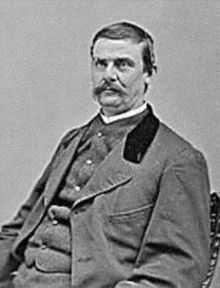John Echols
| John Echols | |
|---|---|
 | |
| Born |
March 20, 1823 Lynchburg, Virginia |
| Died |
May 24, 1896 (aged 73) Staunton, Virginia |
| Place of burial | Thornrose Cemetery, Staunton, Virginia |
| Allegiance |
|
| Service/branch |
|
| Years of service | 1861–65 |
| Rank |
|
| Battles/wars | |
John Echols (March 20, 1823 – May 24, 1896) was a general in the Confederate States Army during the American Civil War.
Biography
Echols was born in Lynchburg, Virginia, and was educated at the Virginia Military Institute, Washington College and Harvard College. A tall imposing man, standing 6 feet 4 inches tall, Echols quickly became a leader among his peers. On becoming a lawyer in 1843 he settled in Union, Monroe County (now West Virginia). Echols represented Monroe County in the Virginia House of Delegates 1852–1853 and in the Virginia Secession Convention of 1861.[1][2] He offered his service to the state's army and was commissioned as a lieutenant colonel. On May 8, 1861, he was ordered by General Robert E. Lee to call out and muster in volunteer forces, not to exceed two regiments, to rendezvous at Staunton for Joseph E. Johnston's fledgling army.[3]
Echols was then assigned command of the 27th Virginia Infantry, leading the regiment in the fighting at the First Battle of Manassas under Stonewall Jackson. He was soon promoted to colonel, serving in the Valley Campaign. He was severely wounded on March 23, disabling him for several weeks. Echols was promoted to brigadier general on April 16, 1862[4] during his convalescence. Later in the year, he was assigned to command a brigade of the army of Western Virginia. He participated as a brigade commander in William W. Loring's occupation of the Kanawha Valley in September. After Loring withdrew to the mountains, Echols replaced him in command of the Department of Western Virginia. He promptly reoccupied Charleston, but was forced to retreat by a superior enemy force.
He resigned his departmental command in the spring of 1863, and, during the following summer, served upon the three-man court of inquiry held in Richmond to investigate the cause of the fall of Vicksburg. Later in the year, he commanded the Confederate forces in the Battle of Droop Mountain, stubbornly resisting a series of Federal attacks. In May 1864, he commanded John C. Breckinridge's right wing at the Battle of New Market in the Shenandoah Valley.
Echols' Brigade was recalled by Robert E. Lee to rejoin the Army of Northern Virginia near Cold Harbor during the Siege of Petersburg. On August 22, 1864, he was given charge of the District of Southwestern Virginia, and on March 29, 1865, Echols was assigned command of the western department of Virginia, relieving General Breckinridge, who had joined the staff of President Jefferson Davis. On April 2, Echols, with nearly 7,000 men, began a hasty march to unite with Lee. He reached Christiansburg, Virginia, on April 10, where he received a telegram announcing Lee's surrender at Appomattox Courthouse. At a solemn council of war, Echols decided to march to unite with Johnston's army, and Echols led two brigades southward towards North Carolina. Subsequently, he accompanied President Davis to Augusta, Georgia.
After the war, Echols resumed the practice of law in Staunton. He helped select the members of the Committee of Nine, a group of state leaders who worked to ensure that the state be readmitted into the Union. Echols returned to the Virginia House of Delegates 1878–1881, representing Staunton and Augusta County; while there, he sided with the Funders against the Readjusters.[1] He became President of the Staunton National Valley Bank, and Receiver and General Manager of the Chesapeake, Ohio, and Southwestern Railroad, living in Kentucky the last ten years of his life as he managed the railroad's affairs.
Echols was twice married, first to a sister of Senator Allen T. Caperton of West Virginia, and, after her death, to Mrs. Mary Cochrane Reid of New York. He died at Oakdene the residence of his son, Edward Echols (later lieutenant governor of Virginia), at Staunton, where he is buried in Thornrose Cemetery.
See also
- List of American Civil War generals
- Brig. Gen. John Echols House
Notes
- ↑ 1.0 1.1 Kromkowski, Charles A. "The Virginia Elections and State Elected Officials Database Project". University of Virginia Library. Retrieved 2013-07-02.
- ↑ Sullivan, Ken (ed.), The West Virginia Encyclopedia, The West Virginia Humanities Council, 2006, pg. 210.
- ↑ The War of the Rebellion: A Compilation of the Official Records of the Union and Confederate Armies, Series 1, Vol. 2, Washington, DC, 1880, pg. 808
- ↑ Eicher, p. 222.
References
- Eicher, John H., and Eicher, David J., Civil War High Commands, Stanford University Press, 2001, ISBN 0-8047-3641-3.
- Evans, Clement A., Confederate Military History, 1899.
- Warner, Ezra J., Generals in Gray: Lives of the Confederate Commanders, Baton Rouge: Louisiana State University Press, 1959, ISBN 0-8071-0823-5.
External links
|